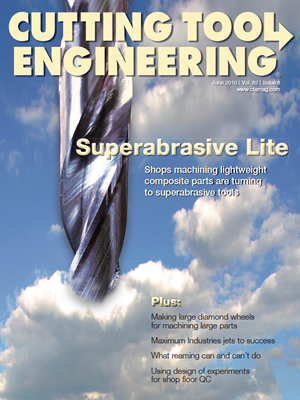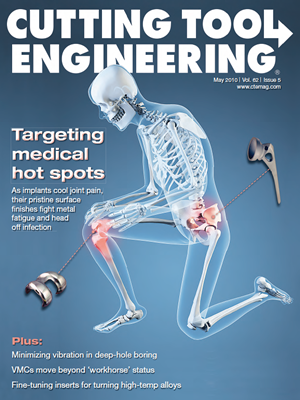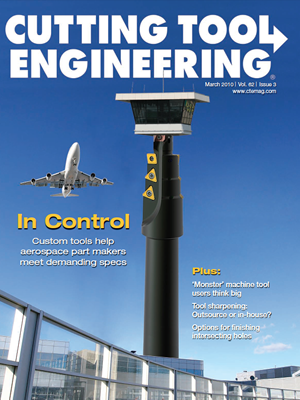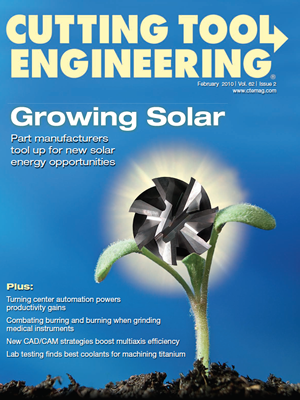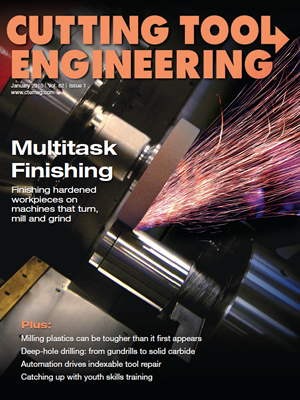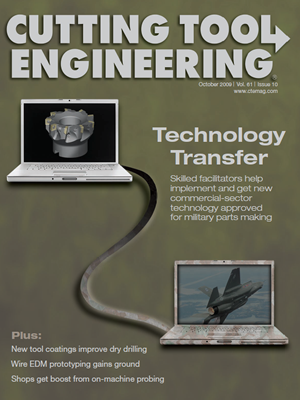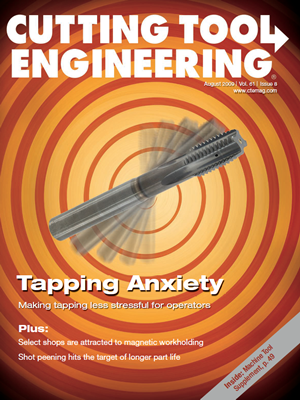July 2010 | Vol. 62 | Issue 7
Several alternatives to mechanical drilling make sense when the application is right. PLUS:
- However you define them, extended-reach toolholders are indispensible in certain applications
- A new concept of calculating the required machining power when milling
- Advances in machine tool controls and software drive better maintenance methods
- When drilling, controlling runout is critical to maximize tool life and reduce cost per hole.
June 2010 | Vol. 62 | Issue 6
Superabrasive tools can be applied to efficiently machine carbon fiber-reinforced plastics. PLUS:
- The development of large diamond wheels for machining large parts
- Texas shop’s waterjet cutting capabilities help protect U.S. soldiers
- Appropriate scenarios for applying a reamer when finishing holes
- Using the design of experiments process for QC on the shop floor.
May 2010 | Vol. 62 | Issue 5
Pristine fi nishes are pivotal for safe and eff ective orthopedic implants. PLUS:
- Minimize vibration—and trouble—when deep-hole boring
- Advanced vertical machining centers provide enhanced performance and value
- Insert geometries for effectively turning high-temperature superalloys
- Is your shop like a clean room? It could be.
April 2010 | Vol. 62 | Issue 4
Teamwork and advanced manufacturing software help moldmakers compete in a tough global market. PLUS:
- Robotic deburring
- Laser-based broken-tool detection systems can be key for shops’ automated operations
- A multifaceted tool kit to help negotiate the many complexities of Swiss-style turning
- Zero-point workpiece clamping systems can slash changeover and setup costs.
March 2010 | Vol. 62 | Issue 3
Custom cutting tools tackle complex aerospace applications. PLUS:
- Applications, accuracy issues and infrastructure requirements for large-envelope machine tools
- A review of tools for fi nishing intersecting holes
- Tool sharpening: in-house vs. outsourcing
- A multifaceted, rational approach to machine tool selection.
February 2010 | Vol. 62 | Issue 2
Machining components for solar power generation systems is a renewable source of business. PLUS:
- Integrated automation of turning centers prove key to meeting production schedules and profit goals
- Strategies for grinding stainless steel medical instruments
- CAD/CAM solutions for increasing the efficiency of multiaxis machining
- Using an independent laboratory to scientifically test coolants provides the impartial data needed to make the right choice for machining titanium
- Learn details about the many products manufacturers off er the metalcutting industry.
January 2010 | Vol. 62 | Issue 1
Using multitask machines to finish hardened workpieces can boost accuracy and cut cycle time. PLUS:
- Milling plastics is just easy enough to be difficult
- Solid-carbide drills penetrate the gundrill deep-hole market
- Sophisticated indexable-tool repair calls for automated equipment
- School programs and competitive events help young machinists hone talents.
December 2009 | Vol. 61 | Issue 12
A growing number of shops are shelving their taps and opting to thread mill heat-treated steel. PLUS:
- Cermet-tipped circular saw blades are eating into carbide’s market share
- Evolving tool and cutter grinder software boosts toolmakers’ and machine shops’ production of advanced cutting tools
- Close-ups of the grinding process via an electron microscope
- Our year-end recap and outlook report finds metworking getting back on its feet
- Learn about companies’ specialties as suppliers to the metalcutting industry.
October 2009 | Vol. 61 | Issue 10
Implementing new technologies helps military parts manufacturing stay on the cutting edge. PLUS:
- Engineered coating combinations control heat and keep chips flying when dry-drilling
- Wire EDM gains ground as the go-to technology for prototyping parts with intricate geometries and those made of hard materials
- On-machine probing can reduce setup time, boost productivity and minimize costs
- Guidelines for turning tool steels apply to both tool- and part-making applications
- Industry publications detail the latest metalcutting products and services.
September 2009 | Vol. 61 | Issue 9
Machining large, compacted graphite iron castings for diesel engine components is rife with challenges—but using the right tools and techniques can help. PLUS:
- Lights-out production can put a shine on the bottom line of even low-volume, multiple-part operations
- As coolant costs climb, it’s more important than ever to know how to properly evaluate fluid products, equipment and services
- Among the strengths of the HSS insert is its flexibility, which makes it the tool-of-choice for some tough applications
- Understanding tool wear and using new coating technologies to combat it can enhance tool life and machining productivity.
August 2009 | Vol. 61 | Issue 8
Understanding tool geometry and selecting the right tap for diff erent workpiece materials can help take the stress out of tapping operations. PLUS:
- U.S. companies that adopt electromagnetic workholders heartily endorse the technology
- Shot peening boosts part performance and life
- Combination tooling, custom fixtures and creative solutions help Apex Precision thrive
- Who should perform spindle maintenance in machine shops?
July 2009 | Vol. 61 | Issue 7
Drills with interchangeable carbide tips provide productivity, fl exibility, accuracy and economy. PLUS:
- Reducing a machine tool’s energy consumption helps achieve ‘green’ machining
- Tool presetters help three shops boost accuracy, productivity and savings
- What to consider when ordering engineered, application-specific milling tools
- Routine grinding machine maintenance boosts productivity and parts accuracy
- Fire suppression systems protect your shop—and your future
- Learn details about the many products manufacturers offer the metalcutting industry.




